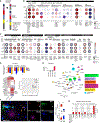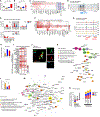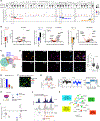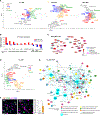Cross-disorder and disease-specific pathways in dementia revealed by single-cell genomics
- PMID: 39265576
- PMCID: PMC12017262
- DOI: 10.1016/j.cell.2024.08.019
Cross-disorder and disease-specific pathways in dementia revealed by single-cell genomics
Abstract
The development of successful therapeutics for dementias requires an understanding of their shared and distinct molecular features in the human brain. We performed single-nuclear RNA-seq and ATAC-seq in Alzheimer's disease (AD), frontotemporal dementia (FTD), and progressive supranuclear palsy (PSP), analyzing 41 participants and ∼1 million cells (RNA + ATAC) from three brain regions varying in vulnerability and pathological burden. We identify 32 shared, disease-associated cell types and 14 that are disease specific. Disease-specific cell states represent glial-immune mechanisms and selective neuronal vulnerability impacting layer 5 intratelencephalic neurons in AD, layer 2/3 intratelencephalic neurons in FTD, and layer 5/6 near-projection neurons in PSP. We identify disease-associated gene regulatory networks and cells impacted by causal genetic risk, which differ by disorder. These data illustrate the heterogeneous spectrum of glial and neuronal compositional and gene expression alterations in different dementias and identify therapeutic targets by revealing shared and disease-specific cell states.
Keywords: KCNH7; MAFG; NFE2L1; NLGN1; OPCML; PDE1C; drug discovery; functional genomics; multi-omics; tauopathy.
Copyright © 2024 Elsevier Inc. All rights reserved.
Conflict of interest statement
Declaration of interests D.H.G. has received research funding from Hoffman-LaRoche for this project. D.C. is a full-time employee of F. Hoffmann-La Roche, Basel, Switzerland. During the study period, D.M. was a full-time employee of F. Hoffmann-La Roche, Basel, Switzerland, and is currently a full-time employee of Biogen, Cambridge, MA, USA.
Figures







Update of
-
Disease-specific selective vulnerability and neuroimmune pathways in dementia revealed by single cell genomics.bioRxiv [Preprint]. 2023 Sep 30:2023.09.29.560245. doi: 10.1101/2023.09.29.560245. bioRxiv. 2023. Update in: Cell. 2024 Oct 3;187(20):5753-5774.e28. doi: 10.1016/j.cell.2024.08.019. PMID: 37808727 Free PMC article. Updated. Preprint.
References
MeSH terms
Grants and funding
LinkOut - more resources
Full Text Sources
Medical
Miscellaneous

